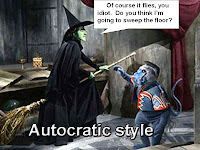Every business executive is a leader, and every leader is expected to be effective; however, there are different types of leadership.
There are also four leadership styles:
To some extent, business managers must be each of these at some time or other. No one leader is just one style and few leaders use just one approach to leadership.
Brief exercise: Look at the chart below. Try to match leadership approaches on the left to leadership styles on the right. Be prepared to give reasons for your choices.
What are some advantages and disadvantages to the way you matched styles and approaches?
A servant leader who consistently favors a participatory style is may be too easily dissuaded from putting bold ideas into action.
A charismatic leader who consistently favors an autocratic style is likely to make mistakes that harm the company, because people tend not to question his decisions until after the harm is done.
A team leader who consistently favors a participatory style may or may not be successful in his approach. It would depend partly on whether participation is democratic, consultative, or by consensus.
Each leadership style has its advantages and disadvantages. Each style of leader should seek balance.
Transformational leaders are often visionary but impractical. Their teams may need the assistance of a managerial type to help guide their dreams to reality.
Even then, the transformational leader will face the challenge of getting others to follow. After all, following a transformational leader always involves change. People who want to change the world still dislike having to change themselves.
Creative Disagreement
Regardless of what kind of leader you are, or what leadership style you adopt, a little disagreement should be healthy for your business.
One of the biggest mistakes a leader can make is trying to stop people from disagreeing. If everyone agrees on an idea from the very beginning, it’s a sure sign that no one has carefully examined the idea from every angle.
Example #1:
Many years ago, government leaders decided that the use of state vehicles (usually cars) had become to costly. They passed a bill requiring government workers to fill out forms before and after each use of a state vehicle. Everyone in the legislature favored the bill, and it quickly passed.
In less than a year, it became clear that the new way of doing things was costing far more than the old way. The bill had sounded like a great idea, no one had questioned it, everyone voted for it, and everyone was WRONG.
Example #2:
During the 1970’s the Equal Rights Amendment (ERA) passed the U.S. Congress with very little discussion or disagreement and was sent to the states for ratification by two thirds of the states. The intent of the law was to give women the same legal rights as men. Over half the states ratified it in less than a year.
By that time, people actually had had time to read it and discuss it. People realized that, in many states, laws designed to protect women would become unconstitutional. The ERA would do other things that the framers of the ERA had never intended. Women’s groups and religious groups began to oppose the ERA.
The ERA, which had been enormously popular at first, became controversial and did not pass.
Examples #3 & #4:
Steve Jobs was a charismatic business leader who founded Apple ® Computer and was its CEO for many years.
Michael Dell was a charismatic leader who founded Dell® Computer and was its CEO for many years.
The boards of directors of both companies fired them for the same reasons: Because they were charismatic, their boards of directors had tended not to question their judgment. As a result, both of them made serious errors of judgment and were fired.
Both of them were later called back as CEO’s, but their boards of directors learned the value of creative disagreement. Steve Jobs retired in 2009.
Example #5:
James Vail, the CEO of the Bell Telephone Company during the 1920’s is considered the most effective business executive of the twentieth century.
At one meeting, a proposal was brought before the board of directors. Everyone agreed that it was a good idea, and they wanted to vote for it immediately.
What do you think Vail said?
He told them to spend some time looking for reasons to disagree with the proposal and then discuss the reasons for their disagreement.
After following Vail’s instructions, the board of directors made several improvements to the original proposal.
Example #6:
U.S. President Franklin D. Roosevelt often used creative disagreement to help him in the decision-making process. He would find two or more officials who disagreed on a policy and invite them to a meeting on the matter.
He would occasionally ask them questions, but he would offer no opinion on the matter. After the meeting was over, he would consider their positions and privately make a decision.
Now it’s your turn.
Suppose you were a transformational leader starting a business and were coming up with a marketing plan? What kind of approach should you take?
Suppose you were a charismatic leader starting a business and were coming up with a marketing plan? What kind of approach should you take?
Suppose you were a team leader starting a business and were coming up with a marketing plan? What kind of approach should you take?
Suppose you were a servant leader starting a business and were coming up with a marketing plan? What kind of approach should you take?








No comments:
Post a Comment